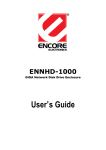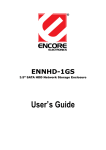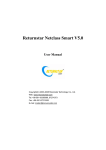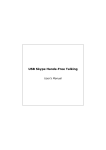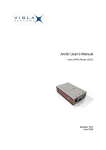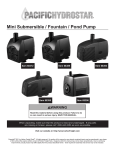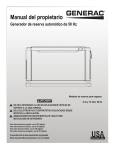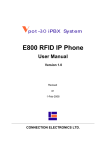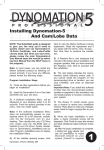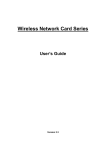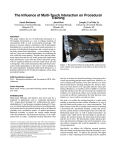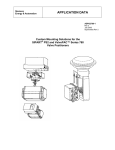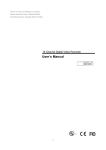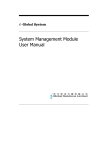Download Gigabit SATA NAS User Manual
Transcript
Gigabit SATA NAS User Manual Include ☆ ☆ ☆ ☆ ☆ Feature Hardware Installation Guide Software Installation Guide Management Guide Appendix G i g a b i t S A T A N A S U s e r M a n u a l TABLE OF CONTENTS OVERVIEW ................................................................................................................................................. 3 INTRODUCTION TO THE GIGABIT SATA NAS WITH USB................................................................ 3 Key Features ......................................................................................................................................... 4 Front Panel ........................................................................................................................................... 5 INSTALLATION GUIDE ............................................................................................................................ 8 HARDWARE INSTALLATION ............................................................................................................. 8 Install a Hard Disk Drive for the Device .............................................................................................. 8 Connect this device to your Local Area Network (LAN)..................................................................... 10 Connect this device to your USB devices............................................................................................ 10 Power on the device .............................................................................................................................11 SOFTWARE INSTALLATION ............................................................................................................ 12 Installing the PNMD ........................................................................................................................... 12 Installing the EZIP Backup ................................................................................................................. 14 MAKING CONNECTION WITH THE DEVICE ...................................................................................... 16 Connecting the device with PNMD ..................................................................................................... 16 To access to folders in the device........................................................................................................ 20 MANAGEMENT GUIDE.......................................................................................................................... 21 STARTING THE GRAPHIC USER INTERFACE (GUI).......................................................................... 21 USING THE GRAPHIC USER INTERFACE (GUI) ............................................................................... 22 Understanding the GUI....................................................................................................................... 22 Management items list ........................................................................................................................ 22 STATUS ....................................................................................................................................... 23 Items.................................................................................................................................................... 23 Information ......................................................................................................................................... 23 DISK ........................................................................................................................................... 24 Folder- Folder Configuration............................................................................................................. 24 Disk- HD Configuration ..................................................................................................................... 29 NETWORK ................................................................................................................................... 30 Host- Host Name Setting..................................................................................................................... 30 IP Address- IP address Setting ........................................................................................................... 30 SYSTEM ...................................................................................................................................... 32 Administrator- Administrator Setting ................................................................................................. 32 Time- System Time Setting .................................................................................................................. 33 User- User Configuration ................................................................................................................... 34 1 G i g a b i t S A T A N A S U s e r M a n u a l Group- Group Configuration.............................................................................................................. 36 OPTION ....................................................................................................................................... 38 FTP- FTP Configuration .................................................................................................................... 38 Security IP- IP Filter Setting .............................................................................................................. 39 Security MAC- MAC Filter Setting ..................................................................................................... 40 File Download- File Download Configuration................................................................................... 41 MAINTENANCE............................................................................................................................. 42 Upload/ Download Your Configuration.............................................................................................. 42 Code Page........................................................................................................................................... 43 Firmware Upgrade ............................................................................................................................. 43 Restart the System ............................................................................................................................... 44 Reset to Factory Default ..................................................................................................................... 44 Sleep mode .......................................................................................................................................... 44 System Shut Down............................................................................................................................... 44 Load Firmware extensions.................................................................................................................. 45 WEB SERVER .............................................................................................................................. 46 Web Server.......................................................................................................................................... 46 USB ........................................................................................................................................... 47 Detail .................................................................................................................................................. 47 Disk Setup ........................................................................................................................................... 47 Printer Setup ....................................................................................................................................... 48 Clean Printer Job Queue .................................................................................................................... 51 MY MEDIA ................................................................................................................................... 52 UPnPAV............................................................................................................................................. 52 iTunes Server.................................................................................................................................... 53 P2P Configuration ............................................................................................................................ 54 APPENDIX ................................................................................................................................................. 55 USING EZIP BACKUP TO BACK UP YOUR FILES.............................................................................. 55 TROUBLE SHOOTING ................................................................................................................... 57 2 G i g a b i t S A T A N A S U s e r M a n u a l Overview Introduction to the GIGABIT SATA NAS with USB Easily back-up your data and share them, this Gigabit SATA NAS with USB is a high-speed, economical, powerful NAS (Network Attached Storage), using the efficient SATA interface and providing an excellent data storage and sharing solution for your small business, SOHO (Small Office or Home Office) or personal requirement. You may also back-up those files from your USB storage devices with pressing the “Backup” button. Embedding FTP server and Web Server. The FTP server allows users to backup and share files with FTP client. The Web server provides an easy way to share files by web site. It also equips 2* USB ports for your USB storage devices and USB printer. With connection to USB storage, the device shares your files in a more flexible way. The set-up procedures and operation are simple and user-friendly. The embedded Linux device works highly stable and is affordable for continuous operation. 3 G i g a b i t S A T A N A S U s e r M a n u a l Key Features ☆ Supports CIFS/SMB for Microsoft ☆ Supports user name & password for Network which allow remote users 50 sets. to retrieve files easily using “My Neighborhood” ☆ Built-in Samba server ☆ WEB-based User Interface (UI) for ☆ Supports access management for 100 easy configuration folders ☆ Support one 3.5” SATA HDD up to ☆ Provides PNMD for user-friendly 750G setup. ☆ Provides Password security management & HD Access for ☆ Supports static IP & DHCP client network environment. ☆ Embeds FTP server for FTP clients ☆ Supports Unicode for to transfer files conveniently. multiple-language characters. ☆ Supports USB mass storage device ☆ Equips one backup button copying files conveniently. ☆ Support AV server for ☆ Supports 32 concurrently connected users. ☆ Embeds Web server for Web site ☆ Compatible with Windows 95 /98 construction. /98SE /ME /XP /2000 /NT4.0/Linux/ MAC OS ☆ Support firmware update over the ☆ Supports group access management. Graphic User Interface (GUI) 4 G i g a b i t S A T A N A S U s e r M a n u a l Front Panel Power Button LEDs Indicator Backup Button Power Button To activate the device, press this Power button for 2 seconds after connecting the device to an appropriate power outlet with the provided power cord. To power off, press the button for two seconds until Power LED starts to blink. LEDs Definition LED Power LAN HDD USB I USB II HDD FULL Backup Status Steady Blue Blinking Blue Off Steady Green Blinking Green Steady Amber Blinking Amber Blinking Amber Off Steady Green Off Steady Green Off Steady Red Off Steady Amber Off Power on System starting\ closing Power off Valid Connection at 1000 Mbps Data transmitting at 1000 Mbps Valid Connection at 10/100 Mbps Data transmitting at 10/100 Mbps Data transmitting on HDD No HDD acting Valid connection on USB I port. Invalid connection on USBI port. Valid connection on USB II port. Invalid connection on USBII port. HDD has run out of space. Space available on HDD Data copying from USB I to internal HD. Data copying finished. 5 G i g a b i t S A T A N A S U s e r M a n u a l Backup Button Press this button to copy those files from USB I port to the internal HD. A new folder will be created automatically in the “share” folder. This new folder is named according to the time you press this button. Note: 1. Only USB I port support this quick backup function. 2. The Backup LED illuminates while data copying. Do not remove this device from USB I port before the Backup LED turns off. 6 G i g a b i t S A T A N A S U s e r M a n u a l Rear Panel FAN USB Port Reset to Default Button LAN Port Power Adapter Socket Reset to Default Button Press and hold the Reset Default Button for 4 seconds to reset all configurations to factory default settings. Note: 1. All configurations that are done by users will be removed from the device. 2. The device also supports restoring factory default settings by software. To get instruction restoring factory default parameters, see” Reset to Factory Default” LAN Port Connect the port with RJ-45 cable to your switch or IP sharing router. Note: To get instruction connecting the device to your LAN, refer to “Making Connection with the Device”. USB Port Connect this port with your USB Storage devices. Power Adapter Socket The socket for connecting the power adapter 7 G i g a b i t S A T A N A S U s e r M a n u a l Installation Guide Hardware Installation Install a Hard Disk Drive for the Device 1. Unscrew the 2 screws and pull out the tray. 2. Place the Hard Disk drive evenly on the hard disk drive base. Slides the Hard Drive to connect to the connector on the device. 8 G i g a b i t S A T A N A S U s e r M a n u a l 3. Secure your hard disk with the included screws in the package. 4. Push tray into Aluminum housing and screw the two pieces together. 9 G i g a b i t S A T A N A S U s e r M a n u a l Connect this device to your Local Area Network (LAN) 1. Connect one end of a RJ-45 cable to the LAN port on the device. 2. Connect the other end of the cable to your IP sharing router or switch Connect this device to your USB devices The device equips two USB ports that allow users to connect the device to a USB storage device . 1. Find the USB cable that came with your USB storage device. Insert the USB Type A end of the cable to the device, the other end to your USB storage. Note: a. The Type A end of the USB cable is usually the end that connects to your computer. b. If you are connecting an external HD to the USB ports on the device, we recommend users to connect the power adapter of the external HD to supply efficient power for your external HD. 2. Insert the other end to your USB storage device. 10 G i g a b i t S A T A N A S U s e r Power on the device 1. Connect the included power cord with the power adapter 2. Connect the connector end to the device and the plug to an outlet. 3. Push the power button to power on. 11 M a n u a l G i g a b i t S A T A N A S U s e r M a n u a l Software Installation Installing the PNMD This PNMD program helps users to get accessed to those NAS in your LAN. Please follow the instructions to install the software. 1. Insert the CD-Rom that came with this product to your CD-Rom drive. The main menu pops up automatically. Click the “Install PNMD” button to start installation. Note: If the auto-run program is not activated, please click on “My Computer”Æ your CD-Rom Drive then click the InstallMenu icon to start the main menu. 2. Click “Next” on the welcome window. 12 G i g a b i t S A T A N A S U s e r M a n u a l 3. Fill your User Name and Company name in their respective blanks. Select if you want this software to be used by anyone who uses this computer or yourself only. Click Next to proceed. 4. Choose the destination folder for this software and click “Next” to start installation. You may click Browse to change the location. 5. Click “Finish” to complete the software installation. 13 G i g a b i t S A T A N A S 6. After successful installation, the U s e r M a n u a l shortcut shows on your windows desktop. Note: For instructions using the software, please refer to chapter “Making Connection with the Device”. Installing the EZIP Backup This EZIP Backup helps users to backup files on your computer to NAS. Please follow the instructions below to install the software. 1. Insert the CD-Rom that came with this product to your CD-Rom drive. The main menu pops up automatically. Click the “Install EZIP Backup” button to start installation. Note: If the auto-run program is not activated, please click on “My Computer”Æ your CD-Rom Drive then click the InstallMenu icon to start the main menu. 2. Click “Next” on the welcome window. 14 G i g a b i t S A T A N A S U s e r M a n u a l 3. Fill your User Name and Company name in their respective blanks. Select if you want this software to be used by anyone who uses this computer or yourself only. Click Next to proceed. 4. Choose the destination folder for this software and click “Next” to start installation. You may click Browse to change the location. 5. Click “Finish” to complete the software installation. 15 G i g a b i t S A T A N A S 6. After successful installation, the U s e r M a n u a l shortcut shows on your windows desktop. Note: For instructions using the software, please refer to chapter “ Using EZIP Backup to backup your files” in Appendix. Making Connection with the Device Connecting the device with PNMD 1. Double click the shortcut on your desktop. The PNMD begins scanning NAS in your LAN. Please click “Next” to proceed after the Welcome window pops up. Note: This window pops up only when there is no device detected. It guides users to attach cables for the device. If the PNMD detects this product successfully, the window is not going to appear. Please skip to step 4 to continue. 16 G i g a b i t S A T A N A S U s e r M a n u a l 2. Connect the power adapter and press the power button to power on the device. Click “Next”. 3. Connect the LAN port to your switch or IP sharing router. The PNMD scanning the device again. 17 G i g a b i t S A T A N A S U s e r M a n u a l 4. After scanning, the menu shows the NAS in your LAN. You may click the button to search for NAS in your LAN again. 5. The window shows the connection status of the NAS in your LAN. You may click on each NAS to get detailed information of each NAS. Select the NAS that you are going to connect to and click the button. Note: The device cannot detect your hard drive if your hard drive is not formatted as EXT3 format. It shows no capacity on this widow. To format your HD, please refer to “HD Format” after accessing the device. 18 G i g a b i t S A T A N A S U s e r M a n u a l 6. You may select “Auto assign IP Address”, which allows the PNMD to assign IP addresses for the device, or select “Use the IP Address as below”, fill in IP address for this device. Enter the username and password and click OK. Note: The default username/ password is admin/ admin. To get information modifying the username and password, see “Administrator- Administrator Setting” 7. After successful IP address setting, the PNMD rescans NAS in your LAN automatically. 8. Select your NAS. You may: z Click the z Click the button. Fill in the username and password and click OK to open the GUI interface. button to access to folders in the NAS or Note: To get instructions using the GUI, please see “Using the Graphic User Interface (GUI)” 19 G i g a b i t S A T A N A S U s e r M a n u a l To access to folders in the device Double click the pops up. shortcut on your desktop to start the PNMD. The PNMD window Select your NAS and click the button. Double click on the folder that you are going to access. An authentication window pops up. Fill in your username and password to access to this folder. Note: 1. We provide one default username/ password as admin/admin. 2. As default, the “Share” folder is created automatically and it can be read/write by all users. 3. You can change the authorities of the three predefined users for getting accessed to each folder. To change their authorities, please see ” To Configure Folder Properties” 4. To add or configure a account, please see “To Configure a User” 5. Users that would like to use another set of username/ password after getting accessed to any folder please log off your operation system and log on again. 20 G i g a b i t S A T A N A S U s e r M a n u a l Management Guide Read this chapter to understand the management interface of the device and how to manage the device. Starting the Graphic User Interface (GUI) The Graphic User Interface (GUI) is the management interface of this device. Most parameters and settings are configured over the GUI. To get access to the GUI, 1. Double click the shortcut on your desktop to start the PNMD. Note: To get instruction installing the PNMD, please see “ Installing the PNMD” 2. The PNMD window pops up. Select your NAS and click the button. 3. When the “Enter Network Password” window pops up, enter a user name and password. 4. Click OK. The GUI Opens. Note: 1. The default user name and password is admin/ admin. To change the username/ password, please refer to “Administrator-Administrator Setting.” 2. Both the User Name and Password are case sensitive and alphanumeric. 21 G i g a b i t S A T A N A S U s e r M a n u a l Using the Graphic User Interface (GUI) This section provides an introduction to the GUI. Understanding the GUI The GUI is consisted of the following components, 1. 2. Configuration categories: Located on the left side of each page. Lists the configuration categories on this device. To get access to each category, click on the button that you are going to configure. Configuration items: Located on the right side of each page. Shows the items that can be configured. You can click on the tabs that listed above to access to each sub-categories. Note: For detail information about configuring each item, please refer to the management instruction for each configuration category. Management items list The following table lists the information and items that you can configure with the GUI. For detail instruction, please refer to the following chapter. Category Status Disk Sub-category Information Status Shows the status information of this device including Host name, IP address, HD used percentage, system up-time, firmware version, current Samba users and FTP users, firmware extension loaded status. Folder To add a new folder, delete a folder, change folder-access authentication and set up folder properties. Disk Network Host IP address System Administrator Time User Group Option FTP To format the connected IDE interface hard disk in EXT3 Format.. To change the device’s host name, Work group name and description. To configure the network settings for the device including IP address, Subnet Mask, Gateway, DNS server, DHCP enable/ disable and Jumbo mode selecting. To change the administrator name and password. To set up the system time zone, synchronize time and assign a timeserver for the device. To add a new user, delete a user, setup user authorities and change user properties. To make users in groups. Add users to groups or delete users from groups. Change FTP properties including Maximum unit number, Port number, Timeout setting and enable/disable anonymous access. 22 G i g a b i t S A T A N A S U s e r M a n u a l Security IP Maintenance Web Server USB My Media To configure the allowed or denied IP addresses for getting access to the device. Security MAC To configure the allowed or denied MAC addresses for getting access to the device. File Download To add, delete download tasks or change download task properties. Maintenance Provides device maintenance including backup the status of your configuration to the device, select code page, firmware upgrade, system restart, resetting factory default, configure sleeping mode, shut system down and load extended firmware. Web Server To change the Web server prosperities. Detail Shows the USB device information that currently connected to the device. Disk Setup To setup or remove the USB device that connected to the device. UPnPAV Server To activate the UPnPAV server ITunes Server To activate the iTunes server P2P To start a BitTorrent downloading task. Status The Status page shows the following information of the device. To open the Status page, click the Status on the configuration categories list. Items Host name IP-address HD used (%) Up-time Version Samba Users FTP Users Firmware extensions Loaded Information The identification of this device. The IP address of the device The usage percentage of HD (Total amount of HD) The estimate time that you power the device on The firmware version of the device. The number of members who is currently using the device by Samba The number of members who is currently using the device by FTP client Check if the extension firmware is installed.. Note: This page shows the device information only. To do more configurations about each item, please refer to their instruction respectively in the following chapters. 23 G i g a b i t S A T A N A S U s e r M a n u a l Disk The Disk page allows users to: 1. Change the properties of folders. 2. Format the hard disk connected to the device with IDE connector. To open the Disk page, click the “Disk” on the configuration categories list Folder- Folder Configuration The folder configuration allows users to add folders, delete folders and change folder properties. To Configure Folder Properties Click on the folder that you are going to configure. 24 G i g a b i t S A T A N A S U s e r M a n u a l The folder configuration page shows up. This page allows users to: y y y Change Folder Name/ Folder Description. Add or remove authorized users or groups for this folder. Change folder-accessing authority level for users and groups. To change the folder name/ folder description 1. Click on “Change Folder Name” or “Change Description” icon. The Folder Name/ Folder Description Setting page shows up. 25 G i g a b i t S A T A N A S U s e r M a n u a l 2. Fill in the new name or new description for the folder and click “Apply”. Note: y Folder Name (0~15 characters): The name for the folder. y Description (0~48 characters): A note for the folder. y Both folder name and description are alphanumeric. y Blank character is not allowed for folder name and description. 3. The folder name/description is replaced successfully. You may click “Change” to do more configurations for this folder or click “Back” to return to folder list. Configure folder-accessing authority level for users and groups. 1. Configure the access-permission rules for all users by pre-defined levels. Select one level and click “Save” to apply this authority for all users. The pre-defined levels use the following access permission rules: Pre-defined Levels Authentication Free Access: No access for all users: Access Authority No authentication. Everyone is allowed to get access to this folder without username and password. No accessing. No user is allowed to get access to this folder. All users are allowed to read in this folder. Modification in this folder is not allowed. All users are allowed to read and write this folder. Only Read access for all users: Read/ Write access for all users: Current Access Permission The folder uses user-defined authority settings. The access permissions in “Group-Authority Setting” for all users: and “User-Authority Setting” will be applied to this folder. 26 G i g a b i t S A T A N A S U s e r M a n u a l 2. Configure the access-permission rules by groups and users: Note: Before starting, you have to click “Current Access Permission for all users” in the “Please set user’s limit for this folder”. By Group: Mark the checkbox to select an authorized group. Select an access-permission rule for this group and click “Save” to apply. By User: Select an access authority for each user. Click “Save” to apply. Tips: To do an efficient access-authority configuration, please refer to the following recommend procedures: Step1. Select a Pre-defined authority level for all users. (Ex, Click “No Access for all users” to configure all users as “Non-access” for this folder. Step2. Click “Current Access Permission for all users” to allow configuration by groups or users. 27 G i g a b i t Step3. Step4. S A T A N A S U s e r M a n u a l Specify the users that have different authorities. Click Save to apply. To Add a New Folder 1. Click the “Add” button on folder list. 2. Specify a folder name and description for the newly added folder. Click “Apply” to enable. Note: y Folder Name (0~15 characters): The name for the folder. y Description (0~48 characters): A note for the folder. y Both folder name and description are alphanumeric. y Blank character is not allowed for folder name and description. 3. Setup the folder properties and click “Save” to apply. Note: For detail folder configuration, see “To configure folder properties” 28 G i g a b i t S A T A N A S U s e r M a n u a l To Delete a Folder 1. Mark the check box of the folder that you are going to delete. 2. Click Delete to delete the folder. Disk- HD Configuration To format your hard disk in EXT3 format: 1. Click “Yes” to execute HD Format. 2. Start formatting after your confirmation. Caution: All files within the hard disk will be erased while HD Format is executed!! Note: The Hard Disk will be formatted as EXT3 format. 3. After confirmation for HD formatting, the system starts formatting the hard disk. It may take several minutes according to the storage size of your hard disk. Please wait and DO NOT execute other configuration for this device while formatting. 29 G i g a b i t S A T A N A S U s e r M a n u a l Network The Network page allows users to: 1. Configure general device information 2. Configure the network setting for the device. To open the Network page, click the Network on the configuration categories list. Host- Host Name Setting Host Name (1~15 characters): Workgroup (1~15 characters): Description (1~48 characters): Define the user-defined device name. Defines the workgroup name for the device which is going to be shown on “Network Neighborhood” Define a note for the device. IP Address- IP address Setting To Enable DHCP Client Click “Enable” to enact this device as a DHCP client and click “Disable” to disqualify. To Configure the IP Addresses for the Device The IP Address Setting contains parameters of the device network setting. To modify, fill in each blanks and click “Apply” to execute. 30 G i g a b i t IP Address: Subnet Mask: Gateway: Primary/Secondary DNS Server: S A T A N A S U s e r M a n u a l Specifies the device IP Defines the Subnet Mask Defines the default gateway Defines the DNS server Jumbo Mode The device supports Jumbo frame for obtaining a more efficient network. You may choose 4000 or 7000 as the size of a packet. To select Jumbo modes, choose a mode from the drop list and click SET to execute. 31 G i g a b i t S A T A N A S U s e r M a n u a l System The System page allows users to: 1. Configuring Administrator name and password. 2. Synchronize system time 3. Add, delete and configure a user 4. Add, delete and configure a group To open the System page, click the System on the configuration categories list. Administrator- Administrator Setting This page provides Administrator Name and password configuration, which are used for getting access to the Graphic User Interface. To modify the Administrator Name and password: 1. Define a Administrator Name (4~16 characters) in the Administrator Name box 2. 3. 4. 5. Fill in the original password (4~16 characters) in the Old Password box. Define a new password (4~16 characters) in the New Password box. Fill in the newly defined password (4~16 characters) in the Confirm Password box. Click “Apply” to execute. Note: 1. The default Administrator Name and password are admin/ admin. 2. The Superuser ID is also the administrator ID while you access folders in this device via samba or ftp. The ID can access all folders in this device. 3. The Administrator Name and password are both case-sensitive and alphanumeric. 4. To enforce the security, it is recommended to change the Administrator Name and password periodically. 32 G i g a b i t S A T A N A S U s e r M a n u a l Time- System Time Setting The Time page provides time synchronizing function. You can synchronize the time by applying the time on your computer to the device or by connecting to a time server. To configure the device time: 1. Select the time zone that corresponds to your region from the Time Zone drop list. 2. Select if applying “Daylight Saving” on system time by marking the checkbox or not. 3. To apply the time on your computer to the device, select “Local Time” and click “Time Sync” button 4. To synchronize the time from a time server, select “Time Server”, fill in a time server address in the Time Server box and click “Time Sync” to execute. 5. Click “Save” to apply your configuration or click “Back” to abort. Note: the synchronized time will be applied by next reboot. To reboot the device, please see “Restart the System” 33 G i g a b i t S A T A N A S U s e r M a n u a l User- User Configuration The User page allows users to: y Add users .Delete users .Modify user properties To Configure a User 1. Move the cursor onto the icon of the user that you are going to configure. 2. You can change the user’s properties by modifying the settings on each item. Specify a name for the newly added user. User Name (4~16 characters): Enter a username for the new user New password (4~16 characters): Enter the new password again to confirm the password Confirm Password (4~16 characters): Fill in a description as a note for the user User Description (0~47 characters) Click “Yes” to allow this user to access the device with FTP client. FTP Access Click “No” to deny FTP access. Note: The username and password for accessing the FTP server are the same with the one that configured above. 34 G i g a b i t 3. S A T A N A S U s e r M a n u a l To change the user name, click the “Change Name button”. The change username page shows up. Fill in the new user name in the “New User Name” box. Click “Apply” to execute. To Add a New User 1. Click the “Add” button on the user list 2. Define the user properties. Note: For more information about each item, see “To Configure a User” 3. Click “apply” to add the new user. To delete a user 1. Select the user that you are going to remove from the device. Mark the check box of the user. 2. Click the “Delete” button to remove the user. 35 G i g a b i t S A T A N A S U s e r M a n u a l Group- Group Configuration The Group page allows users to: y y y Add groups Delete groups Modify group properties To add a new group 1. Click “Add” button. 2. Configure the properties for this group. Group Name (0~15 characters) Group Description (0~48 characters) Authorized Users Enter a group name as the group ID. (Note: The group name must be started with an alphabet) Fill in description as a note for the group Select group members by marking the check boxes. 36 G i g a b i t S A T A N A S U s e r M a n u a l 3. Click “Apply” to add the new group, click ”Undo” to reload previous configuration and click “Back” to return to group list. To delete a group 1. Mark the check box of the group that you are going to delete. 2. Click “Delete” to remove the group or click “Back” to return to group list. To configure a group 1. Click the icon of the group to configure. 2. Modify the properties for the group. Click “Apply” to execute the modification, click ‘Undo” to reload previous configuration or click “Back” to return to group list. Note: For more information about the items, please see “To Add a New Group”. 37 G i g a b i t S A T A N A S U s e r M a n u a l Option The Option page allows users to: 1. Configure FTP settings. 2. Ensure the device security by IP and MAC filter. 3. Download files with this device. To open the Option page, click Option on the configuration categories list FTP- FTP Configuration The device embeds a FTP server that allows users to access this device by FTP client. To setup the FTP server properties, please refer to the following table and click “Apply” to execute your settings. Enable FTP Server: Port Number: Time out: Allow Anonymous: Click Yes to enactive the FTP server function or click NO to disable it. The Port number of the FTP server. Please fill in a number from 1 to 65535. The allowed time that keeps the FTP server connected with a FTP client. The FTP server terminates the connection if the client fails to response during the specified Time Out period. Allow FTP client to connect with the device without username/ password authentication. Note: Please DO NOT use the number 80 as the Port Number. As default, port 80 is the Administration Port for the device. To get more information about the Administration Port, please refer to “Administration WEB” 38 G i g a b i t S A T A N A S U s e r M a n u a l Security IP- IP Filter Setting The Security IP function provides access management by IP address filtering. There are three modes for the IP filter. 1. Disable: Disable the IP Filer function. All IP addresses are allowed to access the device. 2. Allowed: Setup the IP addresses that are allowed to access the device. Only the configured IP addresses have the right to access the device. 3. Denied: Setup the IP addresses that are denied to access the device. The IP addresses that are configured are not allowed to access the device. Tip: For example, to prevent the IP address “192.168.1.3” from connecting with the device: 1. Select “Denied” From the “IP Access Check” drop list. 2. Fill the IP address “192.168.1.3” in the IP Address 1 box. 3. Click “Apply” to execute your configuration. 39 G i g a b i t S A T A N A S U s e r M a n u a l Security MAC- MAC Filter Setting The Security MAC function provides access management by MAC address filtering. There are three modes for the MAC filter. 1. Disable: Disable the MAC Filer function. All MAC addresses are allowed to access the device. 2. Allowed: Setup the MAC addresses that are allowed to access the device. Only the configured MAC addresses have the right to access the device. 3. Denied: Setup the MAC addresses that are denied to access the device. The MAC addresses that are configured are not allowed to access the device. Tip: For example, to prevent the MAC address “D0:E0:7D:CD:C5:5E” from connecting to the device: 1. Select “Denied” From the “MAC Access Check” drop list. 2. Fill the MAC address “D0:E0:7D:CD:C5:5E” in the MAC Address 1 box. 3. Click “Apply” to execute your configuration. 40 G i g a b i t S A T A N A S U s e r M a n u a l File Download- File Download Configuration The File Download page allows users to download files with this device. Note: Before using this function, you should load the “ntx_libra.tgz” first. To get information for installing the “ntx_libra.tgz” file, please see” Load firmware extensions” The instruction below uses the following assumptions: The address for downloading: http://www.(example).com/downloads/sample_file The authorized account name: peter Password:12345 The target folder where the downloaded data is going to be placed: Share Note: The download address, account name and password are made up for the example. There is no such an address and account. To start a download task 1. Fill the address you get for downloading files in the “Address” box. (ex, enter the address http://www.(example).com/downloads/sample_file to the “Address” box) 2. Enter an account name and password in the “Account” and “Password” box respectively. (Ex, enter “peter” in the “Account” box and “12345” in the “Password” box. 3. Select a folder to place the downloaded data in “Save Path” drop list. (Ex, Select the folder Share from the drop list.) 4. Click Apply to perform file download. 5. To cancel or terminate a download task, click the “Del” button to erase the download information then click “Apply” to execute. 6. You may also click the “Status” button to check the download information. 41 G i g a b i t S A T A N A S U s e r M a n u a l Maintenance The Maintenance page allows users to: 1. Backup/ download the configuration status of the device. 2. Select Code Page for the device. 3. Upgrade the device firmware. 4. Restart the system 5. Reset factory default. 6. Apply Character Set and UP&P function to the device. To open the Maintenance page, click the Maintenance on the configuration categories list. Upload/ Download Your Configuration The Upload/ Download configuration column allows users to backup and download the configuration status of the device. Backup the Device Configuration Status: 1. Click the Download button. 2. The File Download dialogue window pops up, click “Save”. 3. Specify a folder to place the downloaded data and click “Save”. Click “Close” to complete. 42 G i g a b i t S A T A N A S U s e r M a n u a l Reload the Device Configuration Status: 1. Click “Browse” and locate the file that you backup before. Note: To know how to backup the configuration status, see” Backup the Configuration Status” 2. Click “Upload” to execute. 3. The system restarts automatically to reload your previous configuration. Code Page The Code Page helps this device to recognize correct file name while users access the device via FTP server. To apply another code page, select a proper code page from the drop list and click “Apply” to execute. Note: As default, the code page is configured to be corresponding to your region. Changing the code page is not recommended unless you got unrecognizable characters on file name or folder name. Firmware Upgrade To upgrade the firmware, click the “Browse” button to locate the firmware. Click the “Update” button to perform firmware upgrade. Note: To get new firmware of the device, please contact your distributor for more information. 43 G i g a b i t S A T A N A S U s e r M a n u a l Restart the System This column allows users to restart the system. To perform system restarting, click the “Restart” button. Reset to Factory Default To restore the factory default configuration for the device, click the “Set to Default” button to execute. Note: 1. All the user-defined configurations will be erased and replaced as factory default setting. 2. We recommend users to backup the configuration status before restoring factory default. To get more information for backup your configuration, see “Backup the Device Configuration Status” Sleep mode This device supports Sleep Mode, which stops the device temporarily while there are no operating on the device for a certain period of time. To enable Sleep Mode, click on the drop list to specify a time and click “Apply” to execute. System Shut Down To turn off the device, click on the shutdown button and wait the device to turn off automatically. 44 G i g a b i t S A T A N A S U s e r M a n u a l Load Firmware extensions To enable the Unicode and UPNP function for the device, you have to install the “ntx_libra.tgz” file to the device before any configuration. To install the file, 1. Insert the included CD and click the “Browse” button. Note: The Install Menu may auto run. Click “EXIT” to close it. 2. Select your CD-Rom drive. Select Firmware ExtensionsÆ Gigabit SATA NAS with USB folder. Select the “ntx_libra.tgz” file and click “Open” to browse the file. 3. Click “Apply” to perform installation. 4. It takes a few seconds to perform installing, please wait upon installation. 45 G i g a b i t S A T A N A S U s e r M a n u a l Web Server Web Server Administration WEB The Administration port is the port for accessing the Web-based management interface. To modify the Administration Port, enter a port number from 1 to 65535 then click Apply to save your configuration. Note: The Port 80 is configured as the default Administrator WEB Server Port. Web Server Configuration The device embeds a WEB server that allows users to construct a Website. To activate the WEB server, 1. Click “Yes” to enable. 2. Specify a port number from 1~65535. 3. Specify a “WEB Folder” where you place your HTML files. Note: 1. The WEB server supports HTML format only. 2. As default, the Port 80 can’t be setup as the Web Server Port for “80" has been configured as the Administration port. 3. We also provide a Website template for you to build-up a Website and enjoy the WEB server properties easily. To use the template, insert the included CD, copy the data in the folder “WEB Template”. Paste those data in the folder that you configured as the “WEB Folder” 46 G i g a b i t S A T A N A S U s e r M a n u a l USB Detail The Detail page shows the information of the connected USB devices: USB Class: Manufacturer: Device Name: USB 2.0/ 1.1: The USB device type. The manufacturer of the connected USB device Name of the connected USB device. The USB standard supported by the connected USB device. Disk Setup The Disk Setup page allows users to: 1. Get information about the connected USB device. 2. Format the connected USB storage device. 3. Safely remove the connected USB device.. USB Storage information Name (1~16 characters): Description: Define a name for the USB storage device. Note: The name is also the folder name that is going to be displayed while access the device form computers. The partition order of the connected device. Note: 1. The device recognizes the first four partitions only. We recommend users not to format your USB device for more than 4 partitions. 2. The device support one connected USB storage device. Only one USB storage device can be recognized while there are two USB storage device connected simultaneously. 47 G i g a b i t Type: Size: Remove button Format button S A T A N A S U s e r M a n u a l The file format of the connected storage device. The size of the connected storage device. Click this button to safely remove the connected device. Click this button to format the connected device in EXT3 file format. Note: Always disconnect your connected USB device by clicking the Remove button. To remove your improperly may lead to data loss Printer Setup Procedures to setup the printer Note: The device supports one connected USB printer only. Printer Connections on both the USB ports may led the printer functioned unsuccessfully. 1. Connect the USB cable of your printer to the device. Power on your printer. 2. Open the GUI and click “Maintenance”. Install the firmware entension file to the device.. Note: To get information for installing the printer server file, please see” Load Firmware extensions” 3. Click USBÆ Detail, you can see the information of your printer. 4. Click Printer Setup, Click “Yes” in the “Printer enable” column and click “Apply” Note: After finishing the four steps above, the printer server function is activated. To 48 G i g a b i t S A T A N A S U s e r M a n u a l setup the computers that are going to use the printer, please follow the instructions from step 5. 5. Double click the shortcut on your desktop to start the PNMD. The PNMD window pops up. Select your NAS and click the button. 6. You can find a printer icon. Double click on this icon to proceed. 7. The system asks for installing the driver for the printer. Click “Yes” on the warning dialogue windows to proceed. 49 G i g a b i t S A T A N A S U s e r M a n u a l 8. Insert your CD that came with your printer. Click the “Have Disk Button” 9. Browse to the driver in your CD. Click “Open” to browse the driver. Tip: The correct driver is usually the file with the product name in“*. inf” format. 50 G i g a b i t S A T A N A S U s e r M a n u a l 10. Click the “OK” button to start driver installation. 11. The printer is ready for use now. Clean Printer Job Queue The Clean Printer Job Queue allows users to clean the pending print jobs that wait for printing. To perform cleaning printer job queue, click the “Execute” button and click “Yes” to confirm. 51 G i g a b i t S A T A N A S U s e r M a n u a l My Media UPnPAV This device supports UPnP AV server, which allows users to play media files with UPnP client (ex. DMA devices). Follow the steps below to enable this function: 1. Click “Yes” in the Enable UPnPAV Server column. 2. Select a folder in the UPnPAV Folder drop list. 3. Place your media files in the folder that you designated as the UPnPAV folder in step 2. 4. Click the Recan button. 5. Click Apply button to activate this function. Note: Please remember to click the Recan button every time when you add new file into the UPnPAV Folder. 52 G i g a b i t S A T A N A S U s e r M a n u a l iTunes Server This page provides activating the iTunes Server on the device. You will be able to play music files on this device with your iTunes client software directly. Please read the following steps to start the iTunes server: 1. Click “Yes” in the Enable iTunes Server column. 2. Select a folder in the iTunes Folder drop list. 3. Place your music files in the folder that you designated as the iTunes folder in step 2. 4. Click the Recan button. 5. Click Apply button to activate this function. Note: Please remember to click the Recan button every time when you add new file into the iTunes Folder. 53 G i g a b i t S A T A N A S U s e r M a n u a l P2P Configuration This device supports BitTorrent downloading client that provides automatic file downloading. To start a downloading task: 1. Click “Yes” in the BitTorrent Enable column. Click Apply to activate the function. 2. Get a *.torrent file for downloading your demanding file. 3. Place this *.torrent file in the “torrents” folder in the device.(ShareÆP2PÆtorrents) 4. The downloading starts automatically. 5. You can specify the Max upload/download speed in the Max upload/download column. Note: 1. The finished file will be saved in the “files” folder in the device. (ShareÆp2pÆdirectories or ShareÆp2pÆfiles) 2. The system allows the max 5 downloading tasks at the same time. 3. The port 6882 can not be blocked to activate the function properly. Please inform your network administrator if your LAN is behind Firewall. 4. All downloading tasks will be terminated automatically while the available HDD space is less than 200Mb. 5. To get information about the downloading status, please fill in “http://(the IP address of the device):4080 in the address column of your Internet browser. Warning: All users of this device are warned against illegal downloading of copyrighted materials. The P2P embedded functionality is provided for downloading authorized files only. Downloading or distribution of unauthorized materials may result in severe civil and criminal penalty. Users of this device are subject to the restrictions of the copyright laws and should accept all the consequences. 54 G i g a b i t S A T A N A S U s e r M a n u a l Appendix Using EZIP Backup to back up your files This program helps users to backup the files on you computer to your NAS. Those back-upped files are going to be compressed as *.zip format in your NAS. 1. Double click the 2. Click the shortcut on your desktop. icon on system tray. The “EZIP Backup” window pops-up. You may click the button to close this program or click the window to system tray. button to minimize this 3. Click “PC Folder Select” button. Browse a folder that you are going to backup and click OK. The folder that you selected shows on the list. 55 G i g a b i t S A T A N A S U s e r M a n u a l 4. Click the “Change NAS” button to select a NAS. Select a NAS in the NAS device drop list. Select a destination folder for locating the back-upped files. 5. Fill in a user name and password for accessing this folder. Select the time that you are going to execute backup. Click “Setting Apply”. Note: You may also mark the “Disable Schedule Backup” checkbox to disable EZIP Backup to backup your files by schedule. 6. Click the “Apply” button on the up-right corner of the window. 7. Click the button to start backup. To restore a back-upped file to your PC, select the file on the list and click to perform restoring. 56 G i g a b i t S A T A N A S U s e r M a n u a l Trouble Shooting 1. How to shut down the device properly? Ans. To shut down the System properly, press the Power button on the front panel for two seconds until Power LED blinks then go off. 2. The PNMD can’t configure My Network setting. Ans. Make sure that your RJ-45 cable is connected with the device and your PC/Switch. Check if the LINK/ACT LED illuminates. Check the power of the device, your PC and Switch. Make sure that it’s on. Check your PC’s IP address, make sure that it has a static IP or connects with a router with DHCP server. For instruction about the IP setting, Please refer to the “IP Protocol Setup” Chapter. Reboot the system with Web-based UI or press the Reset Default Button to restore the factory default setting and reboot. 3. The device can’t find my SATA interface HD Ans. The HD is unformatted. Please format it with our HD Format tool. The partition format of HD is not EXT3, ex. NTFS. Please format it with the provided Format tool. The HD maybe broken. Please change another HD and try again. 4. I use Device as a Web/ FTP server, but the users that outside the LAN can’t access it. Ans. For WAN users to get access to the FTP or WEB server, you should link the device to a router with appropriate configuration. Please make sure that: 1. The NAT functionality is enabled in your router. 2. In the port-mapping session, the “Internal Host IP” should be configured as the IP address of this Device and the value of “Port” should be corresponded to the port number of the WEB server or FTP server you configured. (Ex, If the IP address of your device is 10.10.7.251, the port number of your FTP is configured as 21 and the port for Web Server is as 8888, you should add or modify a port mapping record, set the Internal Host IP address as 10.10.7.251, the Port as 21. then add or modify another port mapping record, set the Internal Host IP address as 10.10.7.251 and the Port as 8888) 3. Before allowing the device to communicate with Internet, we strongly recommend users to add a Firewall device to secure your network from being invading. 57 G i g a b i t S A T A N A S U s e r M a n u a l 5. I can’t access this device. Ans. Check the LINK/ACT LED of Device illuminates. Reboot the system with Web-based UI or press the Default Button to restore the Factory default setting and reboot. Maybe there are too many concurrently connected users. The system blocks the upcoming users after meeting the maximum allowed number. 6. I have accessed the HD, but I can’t access to the folders. Ans. Verify you have the correct username and password. If you have accessed to any folder in the HD and would like to use another set of username/ password for different authority, please log off your operation system and log on again. 7. There are unrecognizable characters as the file name. Ans. Verify if the Unicode file is loaded to the device successfully To get instruction loading the file, please see “Load Firmware extensions” 8. I have followed the procedures to setup the printer and it just doesn’t work. Ans, Check if you power your printer on. Verify that the cables are connected correctly Make sure that you enactive the printer server functionality, you can refer to “Printer setup” for more information You may select an incompatible printer driver. Click StartÆ SetupÆ Control Panel. Double click the printer icon. Remove this printer and install a different driver and try again. The device supports one connected USB printer only. Printer Connections on both the USB ports may led the printer functioned unsuccessfully. 9. I can’t add a new user. Ans, This device supports usernames with lower case only. Please check if you specify a new user with a capital letter. 10. I can’t configure the default user “admin” in User Configuration. Ans, The username and password of the user “admin” can only be configured in the SystemÆ Administrator page. Please note that you will have to login the GUI with this new superuser ID and password after changing it 58 G i g a b i t S A T A N A S U s e r M a n u a l Product Specification Standard IEEE 802.3, IEEE 802.3u, IEEE 802.3ab Support Protocol TCP/IP, HTTP, SMB, FTP, EXT3, DHCP, uPnP Support concurrently connected Users 32 users Interface One 10/100/1000Mbps LAN port 2* USB 1.1/2.0 ports. One USB backup button One Factory Default Setting Button One Power On/Off Switch Button Connection speed 10/100/1000 Mbps Support Hard Diskette One 3.5” SATA interface HDD up to 750G Diagnostic LEDs Power (Blue) LAN (Green, Amber) HDD (Amber) USB I, USB II (Green) HDD Full (Red) Backup (Amber) Dimensions 210x125x75 mm Operating Temperature Operating - 0~40℃; Storing - -10~65℃ Power Supply DC 12V 3A External power adapter M0-90-375G-A 59





























































